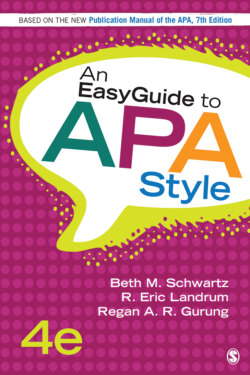Читать книгу An EasyGuide to APA Style - Regan A. R. Gurung - Страница 12
На сайте Литреса книга снята с продажи.
Why APA Style Anyway? Wasn’t MLA Good Enough?
ОглавлениеOdds are you have already learned some of the rules of at least one other style guide, which may have been that of the MLA (Modern Language Association). It might have been in high school or even in a college-level English composition class, but you may have used MLA style if you wrote your papers with footnotes, if you had a bibliography or works-cited page at the end of your paper, or if you used op. cit. or ibid. in your referencing. The typical MLA method of citing involves listing the author followed by the page number where the information came from (compared with APA Style, which uses author followed by year published). So why APA format? Wasn’t MLA good enough?
It is hard to know with certainty why MLA style was not adopted for psychological writing. The Modern Language Association was founded in 1883 (MLA, 2009); the American Psychological Association was founded in 1892. However, the first “Instructions” to APA authors were not published until 1929, and the MLA Handbook is now in its eighth edition—formally known as the MLA Handbook for Writers of Research Papers (MLA, 2016). So, for whatever reason, separate style guides emerged—and there are many more (e.g., Chicago style; American Sociological Association [ASA] style; Turabian style; Modern Humanities Research Association [MHRA] style; and for newspapers, Associated Press [AP] style).
So where did APA Style and format come from? In the very first “Instructions in Regard to Preparation of Manuscript” (1929), a six-member panel recommended “a standard of procedure, to which exceptions would doubtless be necessary, but to which reference might be made in cases of doubt” (p. 57). On a less positive (but believable) note, the 1929 “Instructions” noted that “a badly prepared manuscript always suggests uncritical research and slovenly thinking” (p. 58). Whether fair or not, the quality of our writing reflects the quality of our thinking! Good science requires communication, and if we do not communicate well, even the best ideas in the world will not be understood by others. (Think about the professor who you know is brilliant but has a hard time communicating on a level any student can understand.)
Even though APA format may seem cumbersome to learn, once you are familiar with it, you will feel more comfortable with its conventions. If you have started to read journal articles and papers, you may notice that most, if not all, follow the same organization. The more articles you read, the more thankful you will be that each article is written in the same format and style. It really does make reviewing the literature much easier. We cannot imagine reading a journal article in which the Results section appears before the Method section (and that is not because we lack imagination or are geeks). By following (and relying on) APA Style and format, we provide readers scaffolding to process the complex ideas and information being presented. Ever watch a movie in which the sequence of events is shown out of order (e.g., multiple flashbacks)? Can you tell if something is foreshadowing or background information? Then the movie jumps again. Are we back to the present, or is this a peek into the future? Only once in a while does it work well. (Check out the movies Memento [Todd et al., 2000], Inception [Nolan et al., 2010], and David Lynch’s Mulholland Drive [Edelstein et al., 2001] for real mind-bending experiences). Following a sequence and order provides a framework for understanding what happened, what is happening, and what will happen.
